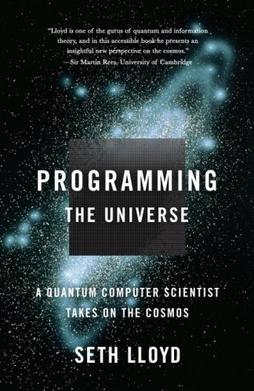
Entropy is a scientific concept, as well as a measurable physical property, that is most commonly associated with a state of disorder, randomness, or uncertainty. The term and the concept are used in diverse fields, from classical thermodynamics, where it was first recognized, to the microscopic description of nature in statistical physics, and to the principles of information theory. It has found far-ranging applications in chemistry and physics, in biological systems and their relation to life, in cosmology, economics, sociology, weather science, climate change, and information systems including the transmission of information in telecommunication.
The holographic principle is an axiom in string theories and a supposed property of quantum gravity that states that the description of a volume of space can be thought of as encoded on a lower-dimensional boundary to the region — such as a light-like boundary like a gravitational horizon. First proposed by Gerard 't Hooft, it was given a precise string-theory interpretation by Leonard Susskind, who combined his ideas with previous ones of 't Hooft and Charles Thorn. Leonard Susskind said, “The three-dimensional world of ordinary experience––the universe filled with galaxies, stars, planets, houses, boulders, and people––is a hologram, an image of reality coded on a distant two-dimensional surface." As pointed out by Raphael Bousso, Thorn observed in 1978 that string theory admits a lower-dimensional description in which gravity emerges from it in what would now be called a holographic way. The prime example of holography is the AdS/CFT correspondence.
Information theory is the scientific study of the quantification, storage, and communication of information. The field was fundamentally established by the works of Harry Nyquist and Ralph Hartley, in the 1920s, and Claude Shannon in the 1940s. The field is at the intersection of probability theory, statistics, computer science, statistical mechanics, information engineering, and electrical engineering.

A theory of everything, final theory, ultimate theory, unified field theory or master theory is a hypothetical, singular, all-encompassing, coherent theoretical framework of physics that fully explains and links together all aspects of the universe. Finding a theory of everything is one of the major unsolved problems in physics. String theory and M-theory have been proposed as theories of everything.
The heat death of the universe is a hypothesis on the ultimate fate of the universe, which suggests the universe will evolve to a state of no thermodynamic free energy and will, therefore, be unable to sustain processes that increase entropy. Heat death does not imply any particular absolute temperature; it only requires that temperature differences or other processes may no longer be exploited to perform work. In the language of physics, this is when the universe reaches thermodynamic equilibrium. The Heat Death theory has become the leading theory in the modern age with the fewest unpredictable factors.
A cyclic model is any of several cosmological models in which the universe follows infinite, or indefinite, self-sustaining cycles. For example, the oscillating universe theory briefly considered by Albert Einstein in 1930 theorized a universe following an eternal series of oscillations, each beginning with a Big Bang and ending with a Big Crunch; in the interim, the universe would expand for a period of time before the gravitational attraction of matter causes it to collapse back in and undergo a bounce.

Leonard Susskind is an American physicist, who is a professor of theoretical physics at Stanford University, and founding director of the Stanford Institute for Theoretical Physics. His research interests include string theory, quantum field theory, quantum statistical mechanics and quantum cosmology. He is a member of the US National Academy of Sciences, and the American Academy of Arts and Sciences, an associate member of the faculty of Canada's Perimeter Institute for Theoretical Physics, and a distinguished professor of the Korea Institute for Advanced Study.

The Fabric of the Cosmos: Space, Time, and the Texture of Reality (2004) is the second book on theoretical physics, cosmology, and string theory written by Brian Greene, professor and co-director of Columbia's Institute for Strings, Cosmology, and Astroparticle Physics (ISCAP).

A physical paradox is an apparent contradiction in physical descriptions of the universe. While many physical paradoxes have accepted resolutions, others defy resolution and may indicate flaws in theory. In physics as in all of science, contradictions and paradoxes are generally assumed to be artifacts of error and incompleteness because reality is assumed to be completely consistent, although this is itself a philosophical assumption. When, as in fields such as quantum physics and relativity theory, existing assumptions about reality have been shown to break down, this has usually been dealt with by changing our understanding of reality to a new one which remains self-consistent in the presence of the new evidence.
Entropy is one of the few quantities in the physical sciences that require a particular direction for time, sometimes called an arrow of time. As one goes "forward" in time, the second law of thermodynamics says, the entropy of an isolated system can increase, but not decrease. Thus, entropy measurement is a way of distinguishing the past from the future. In thermodynamic systems that are not isolated, entropy can decrease with time, for example living systems where local entropy is reduced at the expense of an environmental increase, the formation of typical crystals, the workings of a refrigerator and within living organisms.
Infosphere, analogous to a biosphere, is a metaphysical realm of information, data, knowledge, and communication, populated by informational entities called inforgs.

Programming the Universe: A Quantum Computer Scientist Takes On the Cosmos is a 2006 popular science book by Seth Lloyd, professor of mechanical engineering at the Massachusetts Institute of Technology. The book proposes that the Universe is a quantum computer (supercomputer), and advances in the understanding of physics may come from viewing entropy as a phenomenon of information, rather than simply thermodynamics. Lloyd also postulates that the Universe can be fully simulated using a quantum computer; however, in the absence of a theory of quantum gravity, such a simulation is not yet possible. "Particles not only collide, they compute."

In thermodynamics, entropy is often associated with the amount of order or disorder in a thermodynamic system. This stems from Rudolf Clausius' 1862 assertion that any thermodynamic process always "admits to being reduced [reduction] to the alteration in some way or another of the arrangement of the constituent parts of the working body" and that internal work associated with these alterations is quantified energetically by a measure of "entropy" change, according to the following differential expression:
Charles Seife is an American author and journalist, and a professor at New York University. He has written extensively on scientific and mathematical topics.
In non-technical terms, M-theory presents an idea about the basic substance of the universe. As of 2022, science has produced no experimental evidence to support the conclusion that M-theory is a description of the real world. Although a complete mathematical formulation of M-theory is not known, the general approach is the leading contender for a universal "Theory of Everything" that unifies gravity with other forces such as electromagnetism. M-theory aims to unify quantum mechanics with general relativity's gravitational force in a mathematically consistent way. In comparison, other theories such as loop quantum gravity are considered by physicists and researchers/students to be less elegant, because they posit gravity to be completely different from forces such as the electromagnetic force.
A googol is the large number 10100. In decimal notation, it is written as the digit 1 followed by one hundred zeroes: 10,000,000,000,000,000,000,000,000,000,000,000,000,000,000,000,000,000,000,000,000,000,000,000,000,000,000,000,000,000,000,000,000,000.

Physics is a scientific discipline that seeks to construct and experimentally test theories of the physical universe. These theories vary in their scope and can be organized into several distinct branches, which are outlined in this article.

Decoding Reality: The Universe as Quantum Information is a popular science book by Vlatko Vedral published by Oxford University Press in 2010. Vedral examines information theory and proposes information as the most fundamental building block of reality. He argues what a useful framework this is for viewing all natural and physical phenomena. In building out this framework the books touches upon the origin of information, the idea of entropy, the roots of this thinking in thermodynamics, the replication of DNA, development of social networks, quantum behaviour at the micro and macro level, and the very role of indeterminism in the universe. The book finishes by considering the answer to the ultimate question: where did all of the information in the Universe come from? The ideas address concepts related to the nature of particles, time, determinism, and of reality itself.

The Information: A History, a Theory, a Flood is a book by science history writer James Gleick, published in March 2011, which covers the genesis of the current information age. It was on The New York Times best-seller list for three weeks following its debut.

Too Big to Know: Rethinking Knowledge Now That the Facts Aren't the Facts, Experts Are Everywhere, and the Smartest Person in the Room Is the Room is a non-fiction book by the American technology writer David Weinberger published in 2012 by Basic Books.











